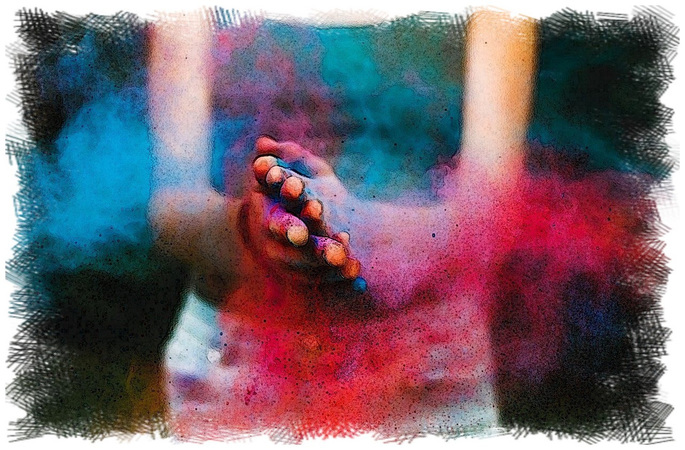It was Holi, a joyful and colourful Indian festival marking the arrival of the Spring harvest, celebrated with crowds of people joyfully rubbing powdered colour on the faces of friends and strangers, and sprinkling coloured water onto each other. Dancing in the streets and the wild beating of drums accompanied all the colour throwing.
What a memorable Holi it was for me!
Having been born and brought up in Bombay, I witnessed the Holi celebrations numerous times. But that day, for whatever reason, I was completely unaware that it was Holi. I had forgotten that it was that time of the year. My focus was elsewhere, and I was beyond excited.
I had been selected, along with three other girls from my school, to make a recording of ‘Mary’s Boy Child’, the popular Christmas Carol, for All India Radio. What a treat! I felt so proud because I loved to sing, and still do to this day. I’m sure there were other girls in the running for the performance too, but I had been selected, and I was overjoyed. I had a lot of butterflies in my stomach during the short trip to school, and I could feel them fluttering around uncontrollably as I got off the bus and started walking up the narrow, crowded lane to my school.
The recording was to be held in the Assembly hall of the school. I remember the name of one of the girls in the group of four, and I’m trying hard to remember the other names, but at present, I cannot. I think two of us were shorter in stature in comparison to the other two. I can’t remember exactly how old I was, but perhaps I was fourteen, a pretty vulnerable age.
I had a new Salwar Kameez (long shirt with pants) tailored for the occasion. The material had been carefully selected with the help of a loving and knowledgeable aunt. Shopping for the white fabric and then looking for suitable bright blue tassels that would be designed to hang from the buttonholes at the top of the kameez took time, patience, and attention to detail. The tailor’s shop was a dark hole-in-the-wall, a few steps from my grandmother’s house, where my aunt also lived. I couldn’t understand how the tailor could sew anything of quality or sew anything at all in that dimly lit hovel. He also had his living quarters behind a curtain in that same room. His scantily clad children ran around, chasing each other and sometimes stepping on the fabric that lay on the floor. In all this chaos, he took my measurements in a laborious fashion and assured me the garments would be ready to meet the deadline I had given him.
‘’Jaroor Memsahib, apka outfit time pe tayar hoga,’’ he said in Hindi. In translation, that would mean, “Certainly miss, your outfit will be ready on time”. How many customers had he said that to, I wondered? Time is a relative thing back home!
He continued,” Phikar ki koyee baat nahi.” Again, that was the customary way of saying, “it’s not a matter for worry”! In reality, that is just an understatement for quite the opposite. You should worry!
Then I asked him about his tailoring charges. Again, he replied with the familiar, ’’Dekha jayega, magar phikar ki koyee baat nahi.’’ In translation, that would mean, “We’ll see, but there’s nothing to worry about”. I wished he had given me a figure so I would know the actual cost, but again that is not the way things functioned growing up. You had to go with the flow!
I loved my country, India, since there was never anything to worry about there! There was perfection in imperfection and so much room for spontaneity. I recall walking past the tailor’s little place and sometimes seeing him bending over the white fabric, the sewing machine whirring furiously. I smiled to myself, knowing he was sewing my outfit. These days we buy ready-made clothes, but when I was young, going to the tailor was a big deal! It now sounds quaint, conjuring up images of a more gracious age. Tailoring is also inordinately expensive nowadays, so people go in for ready-made clothes.
Knowing that, in India, time commitments are subject to individual interpretation, it’s quite likely that both the tailor and the customer went away with different dates in mind. And, therefore I was taken aback when the tailor had actually finished sewing the outfit on time. I simply could not believe it! When I took it back home and tried it on, it was a perfect fit to add to my disbelief. Normally, one has to keep returning to get the tailor to tweak the fit to what was originally agreed upon. They usually listen intently, promise to deliver the product to specifications, and then proceed to improvise the design according to whatever creative thought crosses their imagination.
Now, about ‘Mary’s Boy Child’. The reader might be wondering what Holi or the new outfit had to do with the popular Christmas carol. It’s not as tenuous a connection as you might think when you read the title. For me, the two, that is, Holi and ‘Mary’s Boy Child’, and the connection between them will always remain a sweet memory, indelibly etched on my mind.
The recording of ‘Mary’s Boy Child’ for All India Radio was successfully accomplished. Time to go home now. I said goodbye to the other girls and walked back down the same noisy, crowded lane when it happened. The girls had dispersed in different directions, each going to their own homes in different parts of the city.
Suddenly, a volley of coloured water, like a waterfall, came down on me. Completely stunned, my first instinct was to look up… and then down at myself to see what exactly had hit me. When I looked up, I saw a group of giggling lads on the terrace of a building. They tried to dart out of sight when they saw me looking upwards, but I had spotted them. They had balloons of coloured water in their hands, and they were shouting and leering at me. They seemed to be celebrating some kind of success at having hit their target. Then I looked down at myself. Somehow the coloured water had spared my hair and fallen onto the blue tassels. The blue colour of the tassels ran mercilessly down my white Kameez, and it ended up looking like a kind of tie-dye shirt we had once done in Art class. I had bought the blue tassels, not knowing that the colour would run, but of course, I would have removed them before I washed my outfit in the laundry (those days we washed clothes in a bucket). The running blue colour reminded me of the pan (betel leaf digestive, common in India) that someone had once spat onto my white saree and how the red betel juice had rapidly spread down its side, turning white to red. This was an outfit that had turned from white to blue! Two unnerving experiences, both involving colour!
Why had I been chosen to be at the receiving end of such miseries? Why on a day when colour held such symbolic significance?
Again in sheer shock and disbelief, I stood frozen in my tracks on the street, almost like a statue. Then I began walking briskly and decided to hail a taxi, wanting to get home as quickly as possible. There were no taxis available immediately, so I had to stand on the curb and wait.
Suddenly, I saw a loud group dancing, singing and shouting on the road. They had lots of coloured powder in their hands and were throwing it in puffs of coloured smoke into the air. To my horror, they were also taking some of the red powder and smearing the cheeks of passersby, who seemed to enjoy being decorated. The road was a cloud of red, yellow, orange, blue and green smoke. My eyes were blurred by tears as I hoped I had enough colour running down my clothes for them to ignore me. I prayed they would not throw more colour on me and turn the rest of the white fabric of my clothes into a multicoloured mess. Somehow, my prayers were answered.
Too late, I realized it was Holi. A day on which one wears old clothes that would eventually be thrown away. A day on which there are no limits to colouring one’s world with every colour in a painter’s palette. A day of joy and celebration, of the triumph of Good over Evil. And also, it seems, of blotching white clothes a messy blue. But, I was most thankful that the balloons hadn’t hit me on the way into the recording studio.
As I mentioned earlier, the reader might wonder what the Christmas carol ‘Mary’s Boy Child’ has to do with all this. Well, when I got married, we had carried with us into the ‘Hill Station’ (a mountain resort town) where we were to be working for the next two and a half years, the old Philips turn-table my father had purchased for me lovingly with an entire month’s salary, much to my mother’s chagrin. We had been unable to carry all the records I had acquired during my childhood and youth. Some I purchased (or rather, daddy did) and some I won on radio music quizzes. How I wish I had kept all those records now! So, we had one 45 rpm vinyl record of the Christmas carol ‘Mary’s Boy Child’, sung by Boney M.
We played the vinyl over and over again. Each time we played the carol, the events of that Holiday many years ago tumbled into the present – the singing to record the carol for All India Radio, the ruined outfit. It seems the two events were destined to be connected in some strange way. Call it fate or destiny is what most people might suggest, a kind of ‘everything happens for a reason.
Holi is a joyous, extravagant, and full-of-abandon, the explosion of joy and colour celebration. And, ‘Mary’s Boy Child’ celebrates the reason for God calling on us to welcome His Son into our lives on earth joyously. The pain and shock that 14-year old girl experienced that Holiday, with the colour wrecking her treasured, new outfit, was to be replaced over time with just the beauty of that carol.
The recording of ‘Mary’s Boy Child’ aired over All India Radio sometime later. The trauma and frustration of experiencing the shock of the colour wrecking a lovely outfit, and having to throw it away ultimately, was replaced by the quiet fulfilment of listening to one of the most beautiful Christmas carols with my voice, in harmony with the other three girls.



